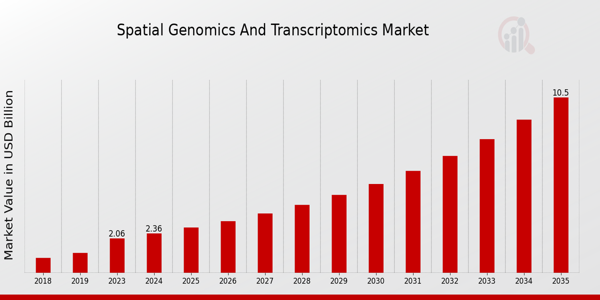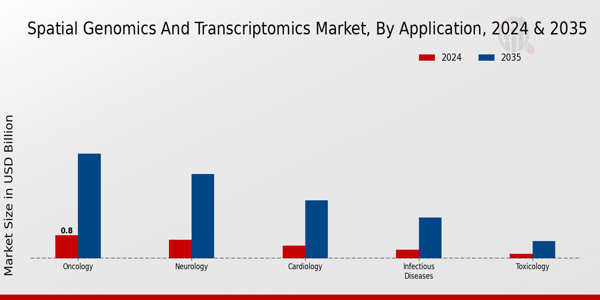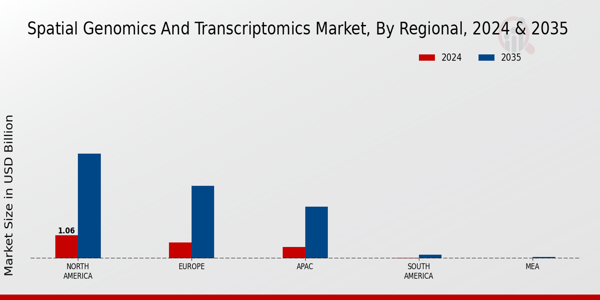Spatial Genomics and Transcriptomics Market Overview
As per MRFR analysis, the Spatial Genomics and Transcriptomics Market Size was estimated at 2.06 (USD Billion) in 2023. The Spatial Genomics and Transcriptomics Market Industry is expected to grow from 2.36(USD Billion) in 2024 to 10.5 (USD Billion) by 2035. The Spatial Genomics and Transcriptomics Market CAGR (growth rate) is expected to be around 14.52% during the forecast period (2025 - 2035).
Key Spatial Genomics and Transcriptomics Market Trends Highlighted
The is experiencing significant growth driven by advancements in technology and an increasing focus on personalized medicine. Improvements in sequencing technologies, such as single-cell RNA sequencing and spatial transcriptomics, facilitate the detailed study of gene expression patterns and cellular environments. The rising prevalence of diseases, particularly cancer, fuels the demand for more precise diagnostic tools and treatments that can target specific genetic profiles.
Additionally, increasing public and private funding for genomic research enhances capabilities in this field, further driving market expansion.The field of spatial genomics and transcriptomics has a lot yet to offer. Advanced machine learning and artificial intelligence can help in decoding complex genetic data. Innovative products and services can be developed faster through strategic partnerships between academic research institutions and biotechnology companies. Molecular and companion diagnostics give a hopeful opportunity for industry stakeholders. Advanced genomic solutions will certainly be in demand as developing countries improve their health systems and research infrastructure.
Recent trends indicate a shift towards personalized and precision medicine, as healthcare providers increasingly rely on spatial genomics and transcriptomics for better patient outcomes. The industry is witnessing growing interest in multi-omics approaches, where different types of biological data are integrated for a more comprehensive understanding of diseases. Moreover, the focus on single-cell analysis is becoming more pronounced as researchers seek to unravel the complexities of cellular heterogeneity. As collaborations and partnerships deepen across various sectors, including pharmaceuticals and technology, the landscape of spatial genomics and transcriptomics continues to evolve, creating a dynamic environment ripe for innovation and exploration.

Source: Primary Research, Secondary Research, MRFR Database and Analyst Review
Spatial Genomics and Transcriptomics Market Drivers
Advancements in Genomics and Transcriptomics Technologies
The Industry is witnessing rapid advancements in genomic and transcriptomic technologies, which is a primary driver for market growth. Innovations such as high-resolution imaging, single-cell sequencing, and enhanced data analysis tools are enabling researchers to obtain a more detailed understanding of biological processes at the cellular and molecular levels. These technologies allow for the mapping of gene expressions within the spatial context of tissues, leading to breakthroughs in disease diagnosis and treatment.
Additionally, the integration of artificial intelligence and machine learning with genomic research is significantly speedier and increases the accuracy of data interpretation, thereby widening the scope of research and clinical applications. The increasing complexity of biological systems and diseases demands these advancements, and as researchers push the boundaries of knowledge, further investment in technology is expected. Moreover, the declining cost of sequencing and the increasing availability of spatial omics platforms are likely to stimulate widespread adoption across various research and clinical settings.This creates a cycle where technological improvements lead to new discoveries, which in turn drive further advancements, establishing a robust momentum for the Industry.
Rising Demand for Personalized Medicine
The rising demand for personalized medicine is significantly influencing the Industry. As healthcare shifts towards more individualized treatment plans, understanding the specific genetic and transcriptomic profile of each patient becomes crucial. This not only enhances treatment efficacy but also minimizes adverse effects. Spatial genomics and transcriptomics provide insights into how various genetic markers respond in different tissue microenvironments, allowing for more tailored therapeutic strategies.This increasing focus on personalized healthcare drives investments in spatial genomics technologies, further propelling market growth.
Growing Applications in Oncology Research
Oncology research is rapidly evolving, and spatial genomics and transcriptomics have emerged as essential tools in this domain. The ability to analyze tumor heterogeneity and understand the tumor microenvironment has made these technologies pivotal in cancer research. Researchers can investigate how different cellular interactions in the tissue context impact tumor progression and treatment responses. This growth in oncology applications is a major driver of the Industry as funding and initiatives directed toward cancer research expand.
Spatial Genomics and Transcriptomics Market Segment Insights
Spatial Genomics and Transcriptomics Market Application Insights
The , particularly within the Application segment, showcases noteworthy growth and diversification, reflecting the increasing relevance of genomic technology in healthcare. By 2024, the market is projected to achieve a revenue of 2.36 USD Billion, demonstrating the sector's commitment to advancing critical applications across various medical domains. As healthcare continues to prioritize precision medicine, the market presents significant opportunities for various applications, including Oncology, Neurology, Cardiology, Infectious Diseases, and Toxicology.
The oncology application holds a prominent position within the market, valued at 0.8 USD Billion in 2024 and expected to grow to 3.6 USD Billion by 2035. This significant growth can be attributed to the rising incidence of cancer globally and the increasing adoption of personalized treatment strategies that utilize spatial genomics and transcriptomics to enhance therapeutic outcomes.
Similarly, Neurology is projected to escalate from 0.65 USD Billion in 2024 to 2.9 USD Billion by 2035. The importance of early and accurate diagnosis in neurological disorders drives this segment's expansion, as advanced genomic techniques contribute to understanding disease mechanisms better. Cardiology, with a valuation of 0.45 USD Billion in 2024, is also growing substantially, reaching 2.0 USD Billion by 2035, as the need for precise genetic screening helps in identifying risk factors and tailoring intervention strategies for heart diseases.
Infectious Diseases, with a market valuation of 0.3 USD Billion in 2024, is projected to rise to 1.4 USD Billion by 2035. The heightened awareness surrounding infectious diseases, particularly highlighted by recent global health events, has accelerated the demand for advanced genomic tools in diagnosing and managing outbreaks.
Lastly, the Toxicology application, although currently valued at 0.16 USD Billion in 2024 and expected to reach 0.6 USD Billion in 2035, plays a critical role in ensuring safety and regulatory compliance in pharmaceutical development. This application is essential for assessing risk factors related to drug exposure, thereby increasing its significance within the broader scope of public health.
The growth trends across these applications underscore not only the expanding market but also the critical role that spatial genomics and transcriptomics play in modern medicine, driving advancements in research, diagnostics, and therapeutics. The segmentation illustrates a multifaceted approach to addressing diverse healthcare needs while fostering innovation and improvement in patient outcomes.

Source: Primary Research, Secondary Research, MRFR Database and Analyst Review
Spatial Genomics and Transcriptomics Market Technology Insights
The within the Technology segment is projected to achieve a valuation of approximately 2.36 billion USD by 2024. The market segmentation reveals key areas of development, including Single-Cell Sequencing and Spatial Transcriptomics, both of which are vital for understanding cellular heterogeneity and localized gene expression.
In Situ Hybridization remains crucial for visualizing specific RNA molecules in their native context, while Laser Capture Microdissection plays a significant role in isolating precise cell populations for further analysis.Next-Generation Sequencing continues to dominate the market, offering unparalleled throughput and accuracy essential for comprehensive genomics studies. These technologies collectively fuel the advancements in personalized medicine and targeted therapies, addressing increasingly complex healthcare challenges and unlocking new research avenues in genomics and transcriptomics fields.
Spatial Genomics and Transcriptomics Market End Use Insights
The is poised for substantial growth, with a projected value of 2.36 billion USD in 2024. The end use of this technology is crucial, comprising various sectors that drive its application and efficacy. Notably, academic research plays a vital role in exploring fundamental biological mechanisms, thereby fostering innovation and advancements in genomics.
Pharmaceuticals utilize spatial genomics and transcriptomics to enhance drug discovery processes, facilitating targeted therapies and personalized medicine.Clinical diagnostics greatly benefits from these methodologies by providing precise biomarker identification and improving patient outcomes. The biotechnology sector dominates this market, leveraging spatial techniques to enhance product development and operational efficiency.
As the data reveals, the increasing acceptance of advanced technologies in healthcare, coupled with collaborations among academia, industry, and clinical laboratories, drives market growth. However, the market faces challenges related to high costs and the need for skilled professionals, creating opportunities for training initiatives and technological advancements addressing the evolving needs of the industry.The continued investment in research and development in these pivotal end-use sectors is expected to further fuel the market’s momentum.
Spatial Genomics and Transcriptomics Market Product Type Insights
The has shown significant potential and expansion, particularly within the Product Type segment. By 2024, the overall market is projected to be valued at 2.36 billion USD, indicating a robust trajectory for growth within this sector. The Product Type component encompasses various essential elements such as instruments, consumables, software, and services, each playing a crucial role in advancing spatial genomics and transcriptomics applications. Instruments, being a fundamental aspect, are vital for executing complex analyses, while consumables support the ongoing research needs through a steady supply of necessary materials.
Software contributes to data analysis and interpretation, facilitating effective outcomes in genomic research. Additionally, services enhance the overall operational capacity, providing expertise and technology support. The segmentation of the highlights the critical nature of these products, demonstrating how they cater to the growing demand for precise and innovative solutions in genomic studies.
With an impressive expected growth trajectory leading to a market value of 10.5 billion USD by 2035, there is substantial opportunity for investment and development within this domain.Market growth is further propelled by evolving technologies and increasing research activities, as well as greater demand for personalized medicine. However, challenges such as regulatory hurdles and high costs may impact growth dynamics.
Spatial Genomics and Transcriptomics Market Regional Insights
The demonstrates significant growth potential across various regional markets, with North America leading with a valuation of 1.06 USD Billion in 2024 and growing to 4.75 USD Billion by 2035, showcasing its dominance in the industry. Europe follows with a valuation of 0.73 USD Billion in 2024, reaching 3.3 USD Billion in 2035, benefiting from advanced research facilities and funding for genomic studies.
The APAC region, valued at 0.52 USD Billion in 2024 and projected to reach 2.34 USD Billion in 2035, is gaining momentum due to increasing investments in healthcare and biotechnology.South America and MEA represent smaller segments, with valuations of 0.04 USD Billion and 0.01 USD Billion in 2024, respectively, growing to 0.18 USD Billion and 0.08 USD Billion by 2035. These markets may offer opportunities for growth, albeit slower, as awareness and infrastructure improve.
The market growth is driven by technological advancements and rising demand for precision medicine, while challenges include high costs and a lack of skilled professionals. The data reflects an evolving landscape where regional dynamics play a crucial role in shaping the future of genomic research.

Source: Primary Research, Secondary Research, MRFR Database and Analyst Review
Spatial Genomics and Transcriptomics Market Key Players and Competitive Insights
The is experiencing significant growth driven by advancements in technology and increasing investments in genomics research. This market is characterized by rapid innovations, collaborations, and the development of novel solutions aimed at enhancing spatial understanding of genomic data and transcriptomic profiles.
With an increasing emphasis on precision medicine, teams in academia and industry are leveraging spatial genomics to gain detailed insights into cellular interactions and microenvironments, which are fundamental to understanding various diseases. The competitive landscape in this market is marked by the presence of numerous key players, each striving to enhance their product offerings, expand their market reach, and address the growing needs in the field of personalized healthcare.
As this market evolves, the competition is expected to intensify, compelling companies to invest in research and development while forming strategic partnerships and collaborations to solidify their positions.F. HoffmannLa Roche is a major player in the , renowned for its commitment to innovation and the development of cutting-edge solutions tailored to the unique challenges of spatial biology.
The company's extensive portfolio features sophisticated technologies that facilitate the analysis of gene expression at single-cell resolution within tissue samples. This capability enhances researchers' ability to understand complex biological systems and disease mechanisms, thereby positioning F. Hoffmann La Roche favorably within the competitive landscape.
Its strong focus on personalized medicine allows the company to address specific customer needs, creating an advantage in delivering tailored solutions to researchers and clinical laboratories. F. HoffmannLa Roche's robust research capabilities established reputation in the pharmaceutical industry, and extensive experience in diagnostics and therapeutics place it in a prime position to continue leading the market.NanoString Technologies has established itself as a significant competitor in the , primarily recognized for its innovative technologies that enable high-throughput analysis of gene expression in a spatial context.
The company's spatial genomics platform is designed to visualize and quantify RNA patterns within tissue samples, providing researchers with unparalleled insights into tissue architecture and cellular interactions. NanoString's robust technological infrastructure, coupled with its dedication to ongoing product development, allows it to meet the evolving demands of the market effectively.
The company possesses a strong reputation among researchers in the fields of oncology, immunology, and other areas, which enhances its market presence. NanoString's commitment to customer collaboration and support further strengthens its competitive positioning, as it actively engages with academic institutions and clinical research organizations to develop novel applications and workflows that advance the field of spatial transcriptomics.
Key Companies in the Spatial Genomics and Transcriptomics Market Include
- F. HoffmannLa Roche
- NanoString Technologies
- 10X Genomics
- Merck KGaA
- Becton Dickinson
- Abcam
- Ginkgo Bioworks
- Molecular Devices
- Bristol Myers Squibb
- PerkinElmer
- Agilent Technologies
- Illumina
- Thermo Fisher Scientific
- BioRad Laboratories
- Zymergen
Spatial Genomics and Transcriptomics Market Industry Developments
Recent developments in the have been significantly influenced by advancements in technology and innovative applications across various research sectors. Companies like F. HoffmannLa Roche and NanoString Technologies are leading the way with novel platforms that enhance spatial analysis for genomic studies. Meanwhile, 10X Genomics is focusing on expanding its product offerings to improve single-cell resolution. Merck KGaA has been active in acquiring complementary technologies to enhance its capabilities in spatial genomics. B
ecton Dickinson has also unveiled new imaging solutions tailored for genomic applications. Additionally, Illumina and Thermo Fisher Scientific are ramping up their investments in research partnerships aimed at addressing critical challenges in genomics. Ginkgo Bioworks and Molecular Devices are collaborating to drive advancements in bioengineering and analytical instrumentation. Notably, the financial dynamics within the market are shifting as companies like Abcam and Zymogen report increased market valuations due to the growing demand for spatial transcriptomics solutions, contributing positively to the overall growth trajectory of the sector. These activities reflect a vibrant and competitive environment conducive to innovation and development in the spatial genomics and transcriptomics landscape.
Spatial Genomics and Transcriptomics Market Segmentation Insights
Spatial Genomics and Transcriptomics Market Application Outlook
- Oncology
- Neurology
- Cardiology
- Infectious Diseases
- Toxicology
Spatial Genomics and Transcriptomics Market Technology Outlook
- Single-Cell Sequencing
- Spatial Transcriptomics
- In Situ Hybridization
- Laser Capture Microdissection
- Next-Generation Sequencing
Spatial Genomics and Transcriptomics Market End Use Outlook
- Academic Research
- Pharmaceuticals
- Clinical Diagnostics
- Biotechnology
Spatial Genomics and Transcriptomics Market Product Type Outlook
- Instruments
- Consumables
- Software
- Services
Spatial Genomics and Transcriptomics Market Regional Outlook
- North America
- Europe
- South America
- Asia Pacific
- Middle East and Africa
| Attribute/Metric Source: |
Details |
| MARKET SIZE 2023 |
2.06 (USD Billion) |
| MARKET SIZE 2024 |
2.36 (USD Billion) |
| MARKET SIZE 2035 |
10.5 (USD Billion) |
| COMPOUND ANNUAL GROWTH RATE (CAGR) |
14.52% (2025 - 2035) |
| REPORT COVERAGE |
Revenue Forecast, Competitive Landscape, Growth Factors, and Trends |
| BASE YEAR |
2024 |
| MARKET FORECAST PERIOD |
2025 - 2035 |
| HISTORICAL DATA |
2019 - 2024 |
| MARKET FORECAST UNITS |
USD Billion |
| KEY COMPANIES PROFILED |
F. HoffmannLa Roche, NanoString Technologies, 10X Genomics, Merck KGaA, Becton Dickinson, Abcam, Ginkgo Bioworks, Molecular Devices, Bristol Myers Squibb, PerkinElmer, Agilent Technologies, Illumina, Thermo Fisher Scientific, BioRad Laboratories, Zymergen |
| SEGMENTS COVERED |
Application, Technology, End Use, Product Type, Regional |
| KEY MARKET OPPORTUNITIES |
Increasing demand for personalized medicine, Advancements in imaging technologies, Growing applications in drug discovery, Rising prevalence of cancer research, Expansion of collaborations and partnerships |
| KEY MARKET DYNAMICS |
Technological advancements in sequencing, Increasing demand for personalized medicine, Growth in research funding, Rising prevalence of cancer, Advancements in data analysis tools |
| COUNTRIES COVERED |
North America, Europe, APAC, South America, MEA |
Frequently Asked Questions (FAQ) :
The market is expected to be valued at 2.36 USD Billion in 2024.
The projected market size for 2035 is estimated to reach 10.5 USD Billion.
The expected CAGR for the market during this period is 14.52%.
North America holds the largest market share with a value of 1.06 USD Billion in 2024.
The market size for Oncology applications is projected to reach 3.6 USD Billion in 2035.
Key players include F. Hoffmann-La Roche, NanoString Technologies, and 10X Genomics among others.
The Neurology application segment is expected to be valued at 0.65 USD Billion in 2024.
The projected market size for the APAC region in 2035 is estimated to be 2.34 USD Billion.
The market is expected to be valued at 0.3 USD Billion in 2024 and grow to 1.4 USD Billion by 2035.
Oncology is anticipated to experience significant growth, with an increase in value expected from 0.8 USD Billion in 2024 to 3.6 USD Billion in 2035.

















